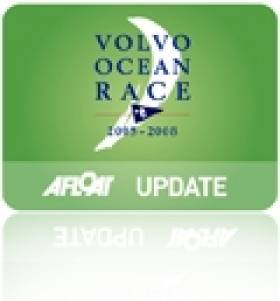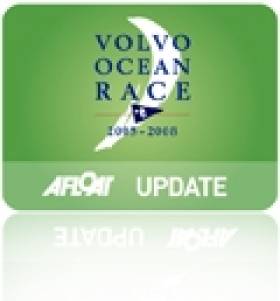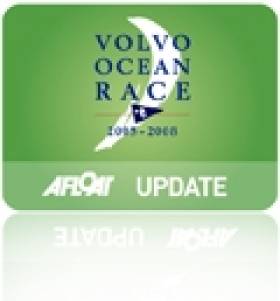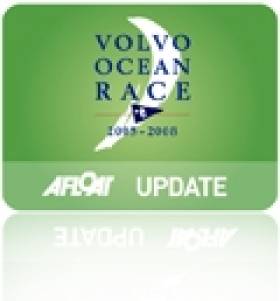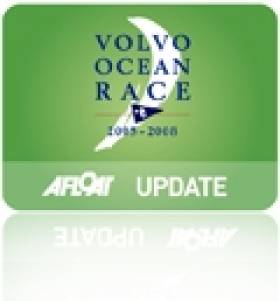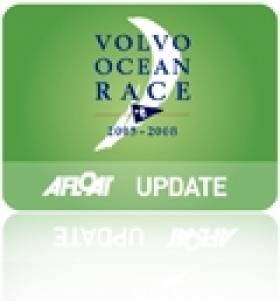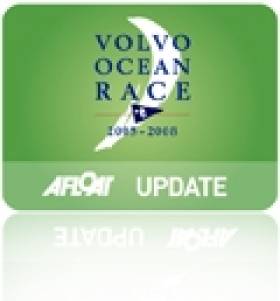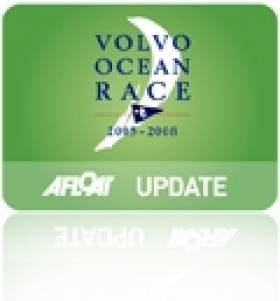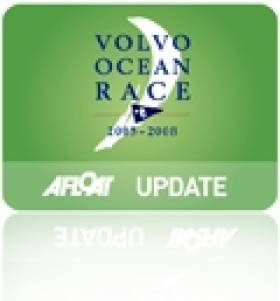Displaying items by tag: Volvo Ocean Race
#VOR - Musandam-Oman Sail skipper Sidney Gavignet has been added to Dongfeng Race Team's crew as they prepare for the start of Volvo Ocean Race Leg 7 from Newport to Lisbon this weekend.
Gavignet comes fresh off the MOD70 trimaran's smashing of the Round Ireland speed sailing record last week to stand in for fellow Frenchman Eric Peron, who will return for the final two legs.
It also marks the latest in a series of crew rotations by skipper Charles Caudrelier on the Leg 6-winning yacht, after Kerry sailor and fellow VOR vet Damian Foxall lent his experience on Leg 5.
“He’s a Volvo Ocean Race expert, and I’ve been wanting to sail again with him for a long time," said Caudrelier of Gavignet. "We sailed together 12 years ago and it went really well so I can only hope this leg will be just as good.”
In other crew change news, Team Brunel have added CAMPER sailor Adam Minoprio to their line-up for the remaining legs.
The youngest ever sailor to be a match-racing world champion "could just make the difference in the last three short legs," said skipper Bouwe Bekking.
And Team Vestas Wind will welcome Australian sailor Tom Addis and Simeon Tienpont, Dutch veteran of the most recent America's Cup-winning crew, when their yacht is ready to rejoin the race in Lisbon for Leg 8 next month.
Their return to the fleet after their devastating grounding in the Indian Ocean late last year is sure to bring more eyes to the action as the finish line draws closer.
No one could be more pleased than VOR chief Knut Frostad, who tells the Yacht Racing Forum about the race's improving commercial position in a still-tough economic climate.
Another happy man is Ian Walker of Abu Dhabi Ocean Racing, who feels his team's performance in the race so far is set to eclipse the "injustice" of setbacks during the 2011-12 race, which included a broken mast in the first race, and limping towards Brazil in the Auckland-to-Itajaí leg with hull damage.
But as he tells Yahoo! News, the Azzam skipper is hesitant to call their current performance "revenge".
"It's like a Formula One race. If you haven't got the car, never mind how good the driver is. We had the potential to win but we never had the opportunity to demonstrate it."
Walker adds: "The race is not over yet at all. But we are in a strong position, a position where we don't have to beat Dongfeng in every leg. Which is important."
#vor – Dongfeng's American dream became a reality just after dark local time (early hours 7th May UTC), winning leg 6 of the Volvo Ocean Race in Newport, USA, beating their arch rivals Abu Dhabi Ocean Racing by just 3 minutes and 25 seconds.
Skipper Charles Caudrelier immediately dedicated this leg win to his shore team: "I would like to dedicate this victory to the shore team. It started in Ushuaia with the shore crew, when first they delivered the boat to Itajai and then fixed the boat and put in a new mast in less than one week. They worked so hard to have the boat ready – I am very proud of them. Everyone on the boat for this leg did a fantastic job and that was the key to winning, for sure. All the team deserves this victory. All the crew have improved, the Chinese improve, we get stronger and stronger each time. To beat Abu Dhabi Ocean Racing shows we have become a great team."
In many ways there was more at stake for Dongfeng – Abu Dhabi were going to be happy with a 2nd in terms of overall points. But for Dongfeng the energy gained from the comeback was worth more than just the points of victory.
The leg from Itajai, Brazil to Newport, USA has been by no means straightforward. A broken water maker 24 hours into the leg nearly threatened the team's hopes and dreams, but the indefatigable Kevin Escoffier (Mr Fixit) managed to make a repair that lasted. Then it was head back into the race and by day 7, the Chinese team were in the lead with 3,364nm to go: "It was a complicated leg, we had a big advantage in speed sometimes, not easy to make the right tactical decisions all the time, so speed was so important. We had something like 10 lead changes. We gained slowly a small advance but every time the other guys came back. Abu Dhabi sailed very well – we made a mistake one or two nights ago – we were 10 miles ahead but they got ahead again and we lost a lot. And then they were ahead of us just two or three hours ago when we hit a light spot. It was just crazy but we had a nice fight with them!"
It was always a question mark as to whether Dongfeng could bounce back after being forced to retire from Leg 5 with a broken mast. "I have never seen the gang so focused and intense," said American Onboard Reporter, Sam Greenfield. "When we won leg 3 into Sanya our lead was comfortable. This time Abu Dhabi was right over our shoulder and breathing down our dry-seals [necks]."
In one of the most intense finishes the Volvo Ocean Race 2014-15 has ever seen, the identical boats and sheer determination of both teams ensured it was a neck and neck battle lasted right up to the finish line. It was clear that both teams were giving it everything they had with every ounce of energy they had left as they approached the finish.
With only three short legs remaining, and a commanding points lead, the race is Abu Dhabi Ocean Racing's to lose. "Now we still have to push hard – this was the first step to come back in the race after the 8 points we got breaking the mast," said Kevin Escoffier. "We still have three legs to come back on Abu Dhabi and I hope they will do a mistake and we can be better than them. For sure they have not made many but statistically they can. Its not over."
LEG 6 TOP THREE RESULTS:
1. DONGFENG/Charles Caudrelier/02:03:00 UTC
2. ABU DHABI OCEAN RACING/Ian Walker/02:06:25 UTC
3. TEAM BRUNEL/Bouwe Bekking/02:56:40 UTC
#VOR - With fewer than 1,000 miles and some three days of sailing to the Leg 6 finish line in Newport, the Volvo Ocean Race is truly on.
Current leaders Dongfeng Race Team face a strong challenge from Abu Dahbi Ocean Racing and third place Team Brunel as they put their chips down on the winning route through the Bermuda Triangle.
Not far behind are MAPFRE and Team Alvimedica, separated by fewer than two nautical miles and picking up a knot of speed over the podium placers – which could accumulate into a threat for the leaders.
Trailing at the back in sixth place are Team SCA, who were the last to gybe northwest on Saturday afternoon (2 May) and haven't been able to make up their lost ground in wind speeds three to four knots off those available to the frontrunners.
Nevertheless, the SCA women will be pushing as hard if not harder than the rest of the fleet as they bear down on Rhode Island – and with little time for the myths that surround the mysterious Bermuda Triangle.
The VOR website debunks the region's Fortean reputation that's long been the stuff of science fiction, boiling it down to the simple fact that as one of the most highly trafficked areas for amateur sailors and pilots, not to mention commercial shipping, it's bound to have more accidents.
Indeed, the bigger risk for the VOR fleet – aside from tiredness and jadedness as the months of offshore racing take their toll – is whether some hapless amateur skipper or pilot might cross their path and scupper their chances in the race standings!
#VOR - What a difference a few days make! After back-marking the Volvo Ocean Race fleet out of Itajaí for the first week of Leg 6, Abu Dhabi Ocean Racing have raced into pole position.
As recently at this past weekend, the crew of Azzam - including Ireland's own Justin Slattery – were still holding up the rear before the big push north that saw Dongfeng Race Team claim the lead.
The Chinese boat, which had Kerry sailor Damian Foxall on deck for the previous leg, held the advantage as the closely packed fleet rounded the north-eastern corner of the South American continent.
But after crossing the Equator for the final time this race, Abu Dhabi Ocean Racing made their move over the course of "a mad few hours" – as skipper Ian Walker put it – sailing along the edge of the Inter Tropical Convergence Zone.
The ITCZ is a belt of low pressure that circles the earth where the trade winds on both sides of the Equator meet.
And it was marked out for the fleet by a massive 50-mile-long cloud with more than 30 knots of wind below it.
"As soon as we got hooked into we were off in a cloud of spray, doing over 25 knots for about two hours. It was incredible!" said Walker. "We sailed right up to Brunel and over the guys to leeward closer to land.
“It came on so quickly that hardly anyone on deck was dressed for the strong wind so we all got totally soaked. We couldn’t even dive below for our wet weather gear, as it needed all of us to keep control.
"So, there we were, ripping along on the very edge of control with water everywhere and just dressed in shorts and t-shirts. We all ended up just laughing at how ridiculous we all must have looked.”
The huge speed boost catapulted Azzam to the front of the pack, which as of lunchtime today (Thursday 30 April) was spread out by some 47 nautical miles between the lead boat and current last-placed Team SCA, and about half that between Abu Dhabi Ocean Racing and fifth-place Team Alvimedica on either side of the fleet.
While the race dashboard shows a tightly knit group of yachts from overhead, the standings show a race of three distinct duels for position.
Ineed, Azzam's lead is a narrow one, as Dongfeng Race Team – out of sight to their port side but not out of mind – are within two nautical miles according to the most recent race tracker update.
At the back, the women of Team SCA and the American-Turkish boat Team Alvimedica are just 5nm apart, while the other battle is for third place as Team Brunel and MAPFRE duel around 16nm from the leaders.
#vor – The Volvo Ocean Race fleet has slightly converged in the past 12 hours as they approach the corner of the South American continent, where the Brazilian coast sketches a right angle at the end of the most easterly littoral of Brazil.
At Cape Calcanhar, located 40 nm north of the city of Natal, there is a lighthouse of 62 meters height that is the tallest in Brazil.
Dongfeng Race Team will approach this point holding an 8.1 nm lead on MAPFRE, who are just half of mile ahead of Team Brunel. 10 nm behind the lead back is Team SCA, currently the most easterly of the six boats, out of the trail of the pack.
Also 10 nm off the leading group is Team Alvimedica, only 0.5 nm miles ahead of Abu Dhabi Ocean Racing.
Once the fleet has passed the shoulder of the continent, they will take up their positions to deal with the doldrums. The good news is that at the moment the routing is showing no big drama to deal with the Intertropical Convergence Zone.
The fleet will be crossing the Equator around Tuesday noon.
Volvo Ocean Race: All Change In Standings As Fleet Nears Recife
#VOR - It's all change in the Volvo Ocean Race this morning (Sunday 26 April) as the pack converges for the buzz past Recife.
The latest watch log from Volvo Ocean Race control put Team Alvimedica still in the lead – but only just.
And as this morning's tracker shows, their gamble to break ahead has not paid off, as they trail behind the bulk of the fleet in fifth position.
Skipper Charlie Enright and his crew were the first to take a chance on Friday (24 April) when they split some 50 nautical miles west of the rest of the fleet.
What's more, the middle-of-the-pack battle between Team Brunel, Team SCA and MAPFRE got even hotter, with less than a third of a nautical mile between their boats.
That excitement calmed down somewhat yesterday (Saturday 26 April) as the yachts locked into their big push north.
With conditions stabilised, and winds averaging 11 knots meaning passing opportunities were minimal for the pack, sailing was expected to be plain till this morning – when the wind was predicted to lift the fleet around Recife.
Alvimedica were drawn back towards the pack, too, and with their lead down to just 2.5 nautical miles as of yesterday evening, today's racing was set to be very interesting.
The current standings prove that: Dongfeng Race Team have claimed the lead some 5.7 nautical miles clear of Team Brunel, who themselves have broken away from their skirmish with MAPFRE and Team SCA, as an average of 2 nautical miles separates their boats.
Alvimedica will be left ruing Friday's decision as they lie some six nautical miles behind the all-women boat, while Abu Dhabi Ocean Racing remain in last place.
But fewer than 20 nautical miles separate their back-marking boat from the leader, so more change is almost certainly in the offing.
High Pressure Situation For Volvo Ocean Race Fleet
#VOR - High pressure, and the attendant lack of wind, is the challenge faced by the navigators with the Volvo Ocean Race fleet now five days into the sixth leg from Itajaí to Newport.
Yesterday (23 April) saw the first split in the pack that was more-or-less tightly knit for the first few days east from their Brazilian stopover, as the crews began picking their spots to tack north.
But there's a fair amount of Brazilian coastline yet to pass – the fleet is still a ways off from Ponta de Olinda – and current lead boat Team Alvimedica is only 17.2 nautical miles clear of previous leg winners Abu Dhabi Ocean Racing bringing up the rear.
Between them there's another close jostle for position between Dongfeg Race Team, Team Brunel, Team SCA and Mapfre, all within just over a nautical mile as the average speed across the fleet drops below six knots.
In the meantime, the teams continue to share their thoughts with the official VOR website in between the relentless tacks that have put any hopes of sleep on the back-burner for now.
Indeed, the sleep deprivation might be affecting the crew of Team Brunel more than others, as skipper Bouwe Bekking took to ribbing their on-board reporter Stefan Coppers.
When he's not keeping the rest of the boat awake with his permanently-on head torch ("He is a like little kid who has a little nightlight right next to him") the Dutch journo's known to strut the deck in his tight boxers.
"he doesn't realise how silly he is looking," says Bekking. "But we gave up a long time ago, it seems to be his 'dresscode'."
It would be enough to distract any sailor, though these hardy souls are keeping their focus as the waiting (and tacking) game continues.
Slow Progress From Itajaí In Volvo Ocean Race Leg 6
#VOR - More than 36 hours into Leg 6 of the Volvo Ocean Race 2014-15 and the fleet is making slow but steady progress east from Itajaí in Brazil.
Indeed, as of 7.40am this morning (Tuesday 21 April) only a little over three nautical miles separated the first-place Team Alvimedica from the back-marking Team Brunel, winners of Sunday's in-port race.
At present the six racing boats are almost due south of Cabo Frio, near Rio de Janeiro.
And the fleet will continue sailing east into the Atlantic for some time till they can catch the right winds for the swing northwards then northwest towards the Caribbean.
According to race meteorologist Gonzalo Infante, there are good offshore options for the teams to consider on this 5,000-nautical-mile coastal leg towards Newport in Rhode Island, but a number of obstacles, such as a return to the Doldrums. lie in wait.
In the meantime – as the boats eek out as much power from their sails as they can, finally reaching a steady 10 knots over the first night and currently averaging 12 knots across the fleet – those challenges will feel like a long way off yet.
#VOR - Team Vestas Wind aren't quite ready to rejoin the Volvo Ocean Race after their mishap in the Indian Ocean last November.
But their name loomed large over yesterday's (Saturday 18 April) in-port race at Itajaí, sailed in far-too-calm conditions that tested the six competing yachts to the limit.
As the official VOR website reports, Team Brunel claimed top honours in what was an "excruciatingly but fascinatingly drawn-out" race.
The win also puts them ahead of the field in the overall standings – but only by one point on closest rivals Abu Dhabi Ocean Racing, who were first to cross the line into the Brazilian port on 5 April.
MAPFRE – who were docked two points last Thursday (16 April) by the ISAF-appointed independent duty for repairs against the rules during Leg 5 – were the first to catch what little wind there was to be had, after an all-nighter to shore up their weakened mast.
Abu Dhabi, meanwhile, duelled with the women of Team SCA, who have been strong in this race's in-port battles. However, a penalty for fouling Team Brunel put paid to the ladies' efforts.
The final showdown was between Abu Dhabi, the Chinese contingent Dongfeng Race Team and the Dutch boat of Team Brunel – and it was to be the latter that pipped the trio at the post.
As for the absent Team Vestas Wind? Progress is being made at their Italian shipyard, with skipper Chris Nicholson saying that "90% of the parts are together".
That's not the same as having a finished boat that's ready to race, of course, as "you’ve got to remind yourself just how complex these boats are, the amount of hydraulics and ropes that goes on – it’s all happening as we speak," he told the VOR website in Itajaí.
But Nicholson is confident that, should plans continue as they are, the team will get "three days on the water before racing" when the fleet assembles in Lisbon for the penultimate leg.
#vor – Abu Dhabi Ocean Racing (Ian Walker/GBR) buried the miserable memories of the Volvo Ocean Race three years ago to win an epic Southern Ocean/south Atlantic crossing in Leg 5 and claim their second stage victory in the Volvo Ocean Race 2014-15. Wexford's Justin Slattery is part of Walker's crew racing as bowman on the favourite in the five boat fleet.
In 2012, Walker's crew were forced to return to Auckland with hull damage and eventually retired from the leg to Itajaí, Brazil.
They must have feared more of the same when Cyclone Pam delayed the departure from New Zealand for three days, but despite taking the worst that the Southern Ocean and then the south Atlantic could throw at them, the Emirati team emerged triumphant after nearly 19 days of ultra-challenging, super-tight sailing.
Amazingly, skipper Ian Walker reported that they had reached Itajaí with the least amount of work for their shore crew to do of any leg so far in this edition.
To add the icing to their cake, Abu Dhabi Ocean Racing set the new best mark in the chase for IWC prize for the most nautical miles (nm) sailed in 24 hours with 551nm leading up to Cape Horn.
The stage victory leaves Walker's team seven points clear at the top of the standings with five of the nine legs now completed.
Leg 5 finishing times
1. Abu Dhabi Ocean Racing - 18 days 23 hours 30 minutes 10 seconds
2. MAFPRE - 19d 00h 02min 56s
3. Team Alvimedica - 19d 00h 24min 32s
4. Team Brunel - 19d 00h 25min 48s
Team SCA (Sam Davies/GBR) had more than their share of problems, damaging three sails and then suffering a port rudder breakage on Sunday. They are expected to finish the leg on Tuesday.


























